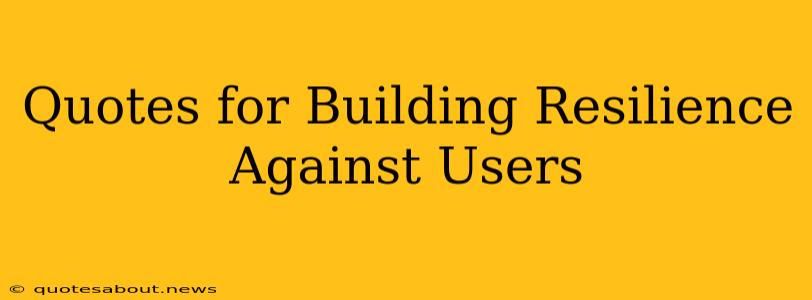Quotes for Building Resilience Against User Challenges: A Guide for Product Teams
Building a resilient product isn't just about coding; it's about anticipating and withstanding the inevitable challenges users throw your way. This requires a mindset shift, a proactive approach to problem-solving, and a healthy dose of resilience. This article explores powerful quotes that encapsulate this critical aspect of product development and offers actionable strategies to build that crucial resilience.
Why Resilience Matters in Product Development
Before diving into the quotes, let's understand why resilience is paramount. A resilient product can handle:
- Unexpected user behavior: Users often don't use products as intended. A resilient system adapts and prevents crashes or data loss.
- High traffic loads: Sudden spikes in usage shouldn't bring your product to its knees.
- Security breaches: Resilience means quick recovery and minimal damage from attacks.
- Negative feedback: Constructive criticism is vital; resilience allows you to learn and improve without being demoralized.
Inspirational Quotes for Fostering Resilience
Here are some quotes that can inspire your team to build a more resilient product:
"The oak sleeps in the acorn; the bird waits in the egg; and in the highest vision of the soul a waking angel stirs. Dreams are the seedlings of realities." – James Allen
This quote highlights the importance of planning and foresight. Just as an acorn holds the potential for a mighty oak, your initial design should incorporate the resilience needed to withstand future challenges. Proactive planning, anticipating potential issues, and building robust systems are key.
"The only way to do great work is to love what you do. If you haven't found it yet, keep looking. Don't settle." – Steve Jobs
Passion fuels resilience. When your team genuinely cares about the product, they're more likely to persevere through difficulties and find creative solutions. A shared vision and a commitment to excellence are vital for building a product that can withstand pressure.
"The difference between ordinary and extraordinary is that little extra." – Jimmy Johnson
Resilience isn't a magical ingredient; it's the result of consistent effort. Paying attention to detail, rigorously testing, and continuously improving are the "little extras" that build a truly resilient system.
"The best and most beautiful things in the world cannot be seen or even touched - they must be felt with the heart." – Helen Keller
This speaks to the importance of user empathy. Understanding user needs and frustrations allows you to anticipate potential problems and design a more robust and user-friendly product. Building resilience requires feeling the impact of your product on users.
Addressing Specific User-Related Challenges:
- H2: How do I make my application more resilient to unexpected user input?
Robust input validation is crucial. Implement checks to ensure data conforms to expected formats and ranges. Handle errors gracefully, providing informative messages to users instead of crashing. Consider using techniques like parameterized queries to prevent SQL injection vulnerabilities.
- H2: What are the best practices for building resilience against high traffic loads?
Employ techniques like load balancing, caching, and horizontal scaling. Regular stress testing simulates high-traffic scenarios, identifying bottlenecks and areas for improvement. Choose infrastructure that can handle sudden increases in demand.
- H2: How can I build a more resilient system to security threats?
Follow secure coding practices, regularly update software and dependencies, and implement robust authentication and authorization mechanisms. Conduct penetration testing to identify vulnerabilities before attackers do. Have a clear incident response plan in place.
Conclusion:
Building a resilient product requires a combination of technical expertise, strategic planning, and a dedicated team. The quotes above serve as reminders of the importance of passion, foresight, attention to detail, and user empathy. By embracing these principles and implementing the strategies discussed, you can create a product that not only withstands user challenges but thrives amidst them.

